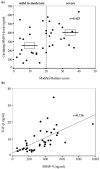Elevated matrix metalloproteinase-9 in patients with systemic sclerosis
- PMID: 15642145
- PMCID: PMC1064883
- DOI: 10.1186/ar1454
Elevated matrix metalloproteinase-9 in patients with systemic sclerosis
Abstract
Matrix metalloproteinase-9 (MMP-9) has been implicated in the pathogenesis of cancer, autoimmune disease, and various pathologic conditions characterized by excessive fibrosis. In this study, we investigated the expression of MMP-9 and its clinical significance in systemic sclerosis (SSc). The patients (n = 42) with SSc had higher concentrations of MMP-9 and of tissue inhibitor of metalloproteinase-1 (TIMP-1) and a higher ratio of MMP-9 to TIMP-1 in sera than healthy controls (n = 32). Serum MMP-9 concentrations were significantly higher in the diffuse type (n = 23) than the limited type of SSc (n = 19). Serum concentrations of MMP-9 correlated well with the degree of skin involvement, as determined by the Rodnan score and with serum concentrations of transforming growth factor beta. Moreover, dermal fibroblasts from patients with SSc produced more MMP-9 than those from healthy controls when they were stimulated with IL-1beta, tumor necrosis factor alpha, or transforming growth factor beta. Such an increase in MMP-9 production was partially blocked by treatment with cyclosporin A. In summary, the serum MMP-9 concentrations were elevated in SSc patients and correlated well with skin scores. The increased MMP-9 concentrations may be attributable to overproduction by dermal fibroblasts in SSc. These findings suggest that the enhanced production of MMP-9 may contribute to fibrogenic remodeling during the progression of skin sclerosis in SSc.
Figures





Similar articles
-
Anti-fibroblast antibodies detected by cell-based ELISA in systemic sclerosis enhance the collagenolytic activity and matrix metalloproteinase-1 production in dermal fibroblasts.Rheumatology (Oxford). 2007 Dec;46(12):1779-85. doi: 10.1093/rheumatology/kem241. Epub 2007 Nov 3. Rheumatology (Oxford). 2007. PMID: 17982166
-
Angiotensin II in the lesional skin of systemic sclerosis patients contributes to tissue fibrosis via angiotensin II type 1 receptors.Arthritis Rheum. 2004 Jan;50(1):216-26. doi: 10.1002/art.11364. Arthritis Rheum. 2004. PMID: 14730619
-
[Systemic sclerosis and scleroderma circumscripta--disturbances of selected serum parameters which are responsible for vascular changes and CD34 expression in involved skin].Przegl Lek. 2009;66(12):1040-5. Przegl Lek. 2009. PMID: 20514902 Polish.
-
[Systemic sclerosis].Nihon Rinsho. 2009 Mar;67(3):519-22. Nihon Rinsho. 2009. PMID: 19280926 Review. Japanese.
-
Silica induced scleroderma--clinical and experimental aspects.J Rheumatol. 1998 Oct;25(10):1917-26. J Rheumatol. 1998. PMID: 9779844 Review.
Cited by
-
Effects of streptolysin o on extracellular matrix gene expression in normal human epidermal keratinocytes.Dose Response. 2011;9(4):554-78. doi: 10.2203/dose-response.10-050.Mamber. Epub 2011 Mar 14. Dose Response. 2011. PMID: 22461761 Free PMC article.
-
Potential Biomarkers in Systemic Sclerosis: A Literature Review and Update.J Clin Med. 2020 Oct 22;9(11):3388. doi: 10.3390/jcm9113388. J Clin Med. 2020. PMID: 33105647 Free PMC article. Review.
-
Evaluation of metalloproteinases 2 and 9 and their inhibitors in physiologic and pre-eclamptic pregnancy.J Clin Lab Anal. 2009;23(2):88-92. doi: 10.1002/jcla.20295. J Clin Lab Anal. 2009. PMID: 19288452 Free PMC article.
-
Membrane array and multiplex bead analysis of tear cytokines in systemic sclerosis.Immunol Res. 2016 Apr;64(2):619-26. doi: 10.1007/s12026-015-8763-9. Immunol Res. 2016. PMID: 26687127
-
Serum IGFBP-2 in systemic sclerosis as a prognostic factor of lung dysfunction.Sci Rep. 2021 May 25;11(1):10882. doi: 10.1038/s41598-021-90333-0. Sci Rep. 2021. PMID: 34035374 Free PMC article.
References
-
- Hoyland JA, Newson L, Jayson MI, Freemont AJ. The vascular basement membrane in systemic sclerosis skin: heterogeneity of type IV collagen. Br J Dermatol. 1993;129:384–388. - PubMed
-
- Gay RE, Buckingham RB, Prince RK, Gay S, Rodnan GP, Miller EJ. Collagen types synthesized in dermal fibroblast cultures from patients with early progressive systemic sclerosis. Arthritis Rheum. 1980;23:190–196. - PubMed
-
- Gerstmeier H, Gabrielli A, Meurer M, Brocks D, Braun-Falco O, Krieg T. Levels of type IV collagen and laminin fragments in serum from patients with progressive systemic sclerosis. J Rheumatol. 1988;15:969–972. - PubMed
Publication types
MeSH terms
Substances
LinkOut - more resources
Full Text Sources
Other Literature Sources
Medical
Research Materials
Miscellaneous

